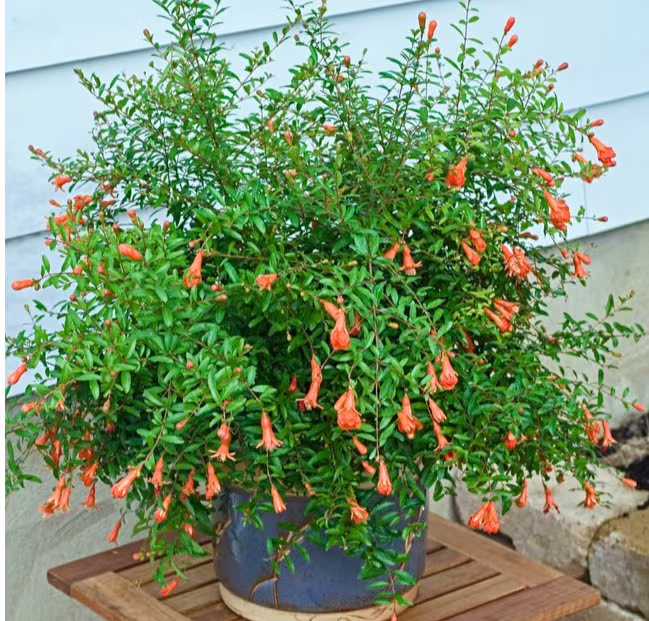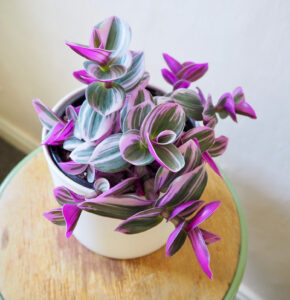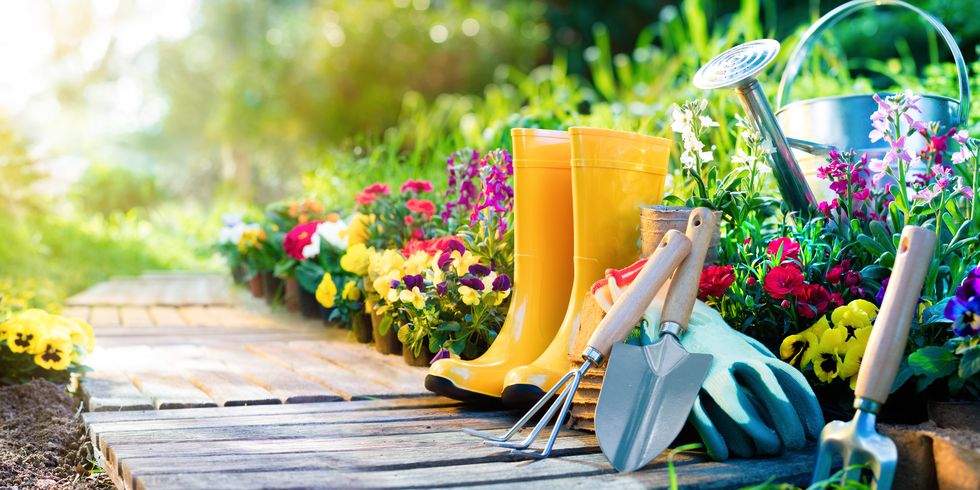The Mini Pomegranate Bush (also known as Punica granatum ‘Nana’) is a dwarf variety of the classic pomegranate tree. It is a compact, ornamental shrub that produces small, vibrant red or orange flowers and small, decorative fruit. This plant is perfect for those with limited space, as it thrives in containers, small gardens, or as a decorative indoor plant. In addition to its striking beauty, the mini pomegranate bush can even produce edible fruit in the right conditions.
Here’s a comprehensive care guide to help you grow a healthy and thriving Mini Pomegranate Bush.
1. Ideal Growing Conditions
For optimal growth, the Mini Pomegranate Bush needs specific conditions.
Key Growing Conditions:
- Light: Mini Pomegranate Bushes need full sun to bloom and produce fruit. Aim for at least 6 hours of direct sunlight per day. If grown indoors, place it near a sunny window that receives plenty of natural light.
- Temperature: This plant thrives in warm conditions and prefers temperatures between 70°F (21°C) and 85°F (29°C) during the growing season. Mini Pomegranate Bushes are hardy in USDA hardiness zones 7-10. In cooler climates, they can be grown in containers and brought inside during the winter months.
- Humidity: Pomegranates prefer moderate humidity levels. They tolerate dry air but will need to be watered regularly during the warmer months.
2. Soil and Potting Requirements
The soil you use plays a significant role in the health of your Mini Pomegranate Bush.
Soil Requirements:
- Well-Draining Soil: Pomegranates dislike waterlogged roots, so it’s crucial to plant them in well-draining soil. A sandy, loamy soil mix is ideal. If you’re planting in a container, ensure it has good drainage holes.
- pH Level: Mini Pomegranate Bushes thrive in slightly acidic to neutral soil with a pH of 5.5 to 7.0. You can test the soil pH regularly and amend it with sulfur or lime if necessary.
Container Selection:
- Potting: When growing in a pot, choose a container that is large enough to allow for root growth, typically 12-16 inches in diameter. Ensure the container has proper drainage to avoid waterlogging.
- Repotting: If grown in a container, the Mini Pomegranate Bush may need repotting every 1-2 years to refresh the soil and provide more space for growth.
3. Watering
Pomegranates are relatively drought-tolerant once established but still require regular watering to ensure healthy growth.
Watering Guidelines:
- Regular Watering: Water your Mini Pomegranate Bush regularly during the growing season, especially when the soil feels dry about 1 inch below the surface. In the summer months, it may need more frequent watering, but make sure the soil drains well to prevent root rot.
- Avoid Overwatering: While these plants enjoy consistent moisture, they do not tolerate soggy soil. Always allow the soil to dry out slightly between waterings.
- Watering Schedule: In cooler months (fall and winter), reduce watering as the plant’s growth slows down and it enters dormancy.
4. Fertilizing
Regular fertilization is important to keep your Mini Pomegranate Bush healthy and encourage blooming and fruiting.
Fertilizing Tips:
- Balanced Fertilizer: Use a balanced, slow-release fertilizer for fruiting plants, with a ratio of 10-10-10 or similar. Avoid over-fertilizing, as too much nitrogen can lead to excessive leafy growth without flowers.
- Fertilizing Schedule: Apply fertilizer in early spring when the plant begins to grow actively and again in mid-summer. In late fall and winter, stop fertilizing as the plant enters its dormant period.
- Organic Fertilizers: You can also use organic fertilizers such as compost, well-aged manure, or fish emulsion to provide nutrients in a slower, more sustainable way.
5. Pruning and Maintenance
Pruning is essential for maintaining the shape and health of the Mini Pomegranate Bush. It also encourages better airflow and flowering.
Pruning Tips:
- Early Spring Pruning: Prune your Mini Pomegranate Bush in early spring before new growth begins. Remove dead, damaged, or diseased branches to promote new growth and maintain a neat shape.
- Shaping the Plant: Trim back any long or leggy stems to encourage bushier growth. Prune selectively to open up the center of the plant and improve air circulation, which helps reduce the risk of fungal diseases.
- Deadheading: Remove any dead flowers to prevent the plant from expending energy on seed production, especially if you’re growing it primarily for its ornamental value rather than the fruit.
6. Pests and Diseases
While Mini Pomegranate Bushes are relatively resistant to pests, they can occasionally be affected by certain insects and diseases.
Common Pests:
- Aphids: Small, green or black insects that suck sap from the leaves and stems. If you notice aphids, wash them off with a strong stream of water or treat the plant with insecticidal soap.
- Pomegranate Fruit Moths: These moths can infest the fruit, causing it to rot. They can be controlled using insecticides or by removing affected fruit promptly.
- Whiteflies: Small, winged insects that suck sap from the leaves and cause them to yellow. Treat them with insecticidal soap or neem oil to control the infestation.
Common Diseases:
- Powdery Mildew: A fungal disease that appears as white, powdery spots on the leaves. Avoid overhead watering and ensure good air circulation to reduce the risk. If powdery mildew appears, treat it with fungicides or a natural remedy like a mixture of water and baking soda.
- Root Rot: This can occur if the plant is overwatered or planted in poorly draining soil. Ensure the pot has proper drainage and water only when the soil feels dry.
- Leaf Spot: This fungal disease causes circular spots on the leaves. Remove infected leaves and use a fungicide to prevent further spread.
7. Winter Care
During the colder months, the Mini Pomegranate Bush requires special care, particularly in regions with freezing winters.
Winter Care Tips:
- Indoor Care: If grown in a container, bring the plant indoors during the winter months to protect it from frost. Place it in a sunny spot, such as near a south-facing window, but away from cold drafts or heat sources.
- Mulching for Outdoor Plants: For plants growing outdoors in colder climates, mulch around the base to protect the roots from freezing temperatures. Use straw, leaves, or other organic mulch material.
- Dormancy: Mini Pomegranate Bushes will enter dormancy during the winter. Watering should be reduced, and the plant’s growth will slow down.
8. Fruit Production
If you’re hoping to grow edible pomegranates, your Mini Pomegranate Bush will need the right conditions for fruiting.
Fruit Production Tips:
- Pollination: While pomegranate flowers are self-pollinating, they will produce more fruit with the help of pollinators like bees. If grown indoors, you can hand-pollinate by gently brushing the flowers with a small paintbrush to transfer pollen from one flower to another.
- Time to Fruit: Mini Pomegranate Bushes typically begin to produce fruit in their second or third year of growth. The fruit will be smaller than the typical pomegranate but will still have the same tangy flavor.
- Harvesting: Fruit is usually ready to harvest in late summer to fall, when the fruit becomes a deep reddish color. The fruit will not continue ripening after being picked, so make sure it’s fully mature before harvesting.
9. Propagation
You can propagate a Mini Pomegranate Bush through cuttings or by seed.
Propagation by Cuttings:
- Take a 4-6 inch cutting from a healthy stem, ensuring there are no flowers or fruit.
- Remove the lower leaves, leaving a few at the top.
- Dip the cut end in rooting hormone.
- Plant the cutting in a pot with well-draining soil and water lightly.
- Cover the cutting with a plastic bag or dome to maintain humidity and place it in a warm location with indirect sunlight.
- Once the cutting has rooted, transplant it into a larger pot or directly into the ground.
Propagation by Seed:
- To propagate by seed, collect the seeds from a mature fruit, clean them thoroughly, and plant them in a well-draining seed-starting mix. Keep the soil moist and warm until the seeds germinate, which can take 2-3 weeks.
Conclusion
The Mini Pomegranate Bush is a fantastic addition to small gardens, containers, or indoor spaces. With the right care, including proper sunlight, watering, and soil conditions, your plant will thrive, producing beautiful flowers and potentially even small, edible pomegranates. Whether you’re growing it for its ornamental beauty or its fruit, the Mini Pomegranate Bush will provide you with year-round interest and rewards.
Welcome To My Garden Channel
My Garden Channel is a website that provides information and resources for gardening enthusiasts. The website includes the following sections: Overall, My Garden Channel is a website that aims toRead More
White Crown of Thorns Care Guide Euphorbia milii (White-flowered Cultivars)
The White Crown of Thorns is a unique, eye-catching succulent shrub known for its spiny stems and delicate white flowers that bloom almost year-round in warm conditions. A white cultivarRead More
White Columbine Care Guide Aquilegia spp. (White Varieties)
White columbine is a charming spring-blooming perennial that brings elegance and softness to any garden. Belonging to the Aquilegia genus, these plants are native to woodland and meadow areas inRead More
White Chiffon Hibiscus Care Guide Hibiscus syriacus ‘White Chiffon’
White Chiffon Hibiscus is a deciduous flowering shrub known for its pure white, semi-double blooms that resemble crepe paper or chiffon fabric. A cultivar of Hibiscus syriacus (also called RoseRead More
Proudly powered by WordPress






